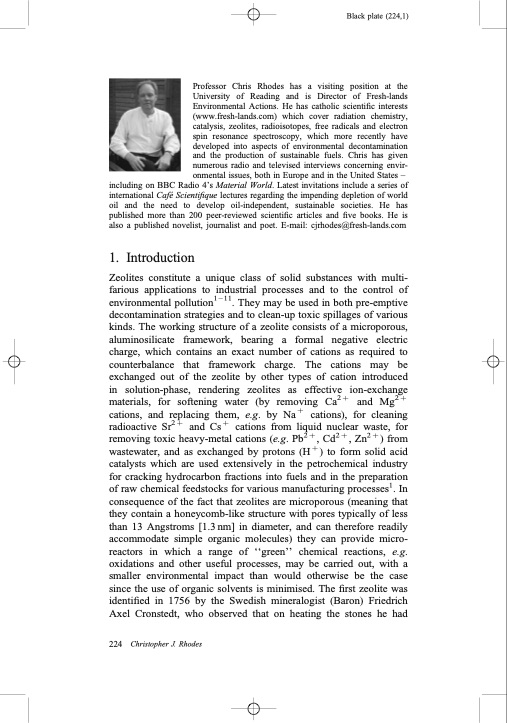
PDF Publication Title:
Text from PDF Page: 002
Professor Chris Rhodes has a visiting position at the University of Reading and is Director of Fresh-lands Environmental Actions. He has catholic scientific interests (www.fresh-lands.com) which cover radiation chemistry, catalysis, zeolites, radioisotopes, free radicals and electron spin resonance spectroscopy, which more recently have developed into aspects of environmental decontamination and the production of sustainable fuels. Chris has given numerous radio and televised interviews concerning envir- onmental issues, both in Europe and in the United States – including on BBC Radio 4’s Material World. Latest invitations include a series of international Cafe ́ Scientifique lectures regarding the impending depletion of world oil and the need to develop oil-independent, sustainable societies. He has published more than 200 peer-reviewed scientific articles and five books. He is also a published novelist, journalist and poet. E-mail: cjrhodes@fresh-lands.com 1. Introduction Zeolites constitute a unique class of solid substances with multi- farious applications to industrial processes and to the control of environmental pollution1 – 11. They may be used in both pre-emptive decontamination strategies and to clean-up toxic spillages of various kinds. The working structure of a zeolite consists of a microporous, aluminosilicate framework, bearing a formal negative electric charge, which contains an exact number of cations as required to counterbalance that framework charge. The cations may be exchanged out of the zeolite by other types of cation introduced in solution-phase, rendering zeolites as effective ion-exchange materials, for softening water (by removing Ca2 þ and Mg2 þ cations, and replacing them, e.g. by Naþ cations), for cleaning radioactive Sr2 þ and Cs þ cations from liquid nuclear waste, for removing toxic heavy-metal cations (e.g. Pb2 þ , Cd2 þ , Zn2 þ ) from wastewater, and as exchanged by protons (H þ ) to form solid acid catalysts which are used extensively in the petrochemical industry for cracking hydrocarbon fractions into fuels and in the preparation of raw chemical feedstocks for various manufacturing processes1. In consequence of the fact that zeolites are microporous (meaning that they contain a honeycomb-like structure with pores typically of less than 13 Angstroms [1.3 nm] in diameter, and can therefore readily accommodate simple organic molecules) they can provide micro- reactors in which a range of ‘‘green’’ chemical reactions, e.g. oxidations and other useful processes, may be carried out, with a smaller environmental impact than would otherwise be the case since the use of organic solvents is minimised. The first zeolite was identified in 1756 by the Swedish mineralogist (Baron) Friedrich Axel Cronstedt, who observed that on heating the stones he had 224 Christopher J. Rhodes Black plate (224,1)PDF Image | Properties and applications of zeolites

PDF Search Title:
Properties and applications of zeolitesOriginal File Name Searched:
003685010x12800828155007.pdfDIY PDF Search: Google It | Yahoo | Bing
CO2 Organic Rankine Cycle Experimenter Platform The supercritical CO2 phase change system is both a heat pump and organic rankine cycle which can be used for those purposes and as a supercritical extractor for advanced subcritical and supercritical extraction technology. Uses include producing nanoparticles, precious metal CO2 extraction, lithium battery recycling, and other applications... More Info
Heat Pumps CO2 ORC Heat Pump System Platform More Info
| CONTACT TEL: 608-238-6001 Email: greg@infinityturbine.com | RSS | AMP |